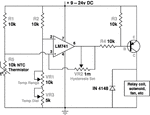
- Joined
- Jul 4, 2009
- Messages
- 16,506
- Helped
- 5,157
- Reputation
- 10,347
- Reaction score
- 5,208
- Trophy points
- 1,393
- Location
- Aberdyfi, West Wales, UK
- Activity points
- 139,586
Seriously - I would use a small MCU for this if you want accuracy and stability. I appreciate you are trying to avoid using one but the cost will probably be lower overall and there are many advantages such as combining the temperature control and motor controls.
I would do it this way:
Simple MCU (8-pin 16F683 comes to mind because it has PWM and ADC on board) reads a temperature sensor and produces a proportional PWM output to switch current through some 10W power resistors. That avoids the point source of heat and hysteresis problems and would be far more reliable than a flashing light bulb. Total cost would be very low and almost no electronics needed. It can also run on low voltage for extra safety.
Brian,
I would do it this way:
Simple MCU (8-pin 16F683 comes to mind because it has PWM and ADC on board) reads a temperature sensor and produces a proportional PWM output to switch current through some 10W power resistors. That avoids the point source of heat and hysteresis problems and would be far more reliable than a flashing light bulb. Total cost would be very low and almost no electronics needed. It can also run on low voltage for extra safety.
Brian,





